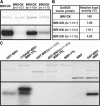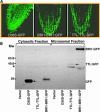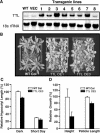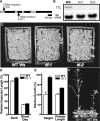The Arabidopsis transthyretin-like protein is a potential substrate of BRASSINOSTEROID-INSENSITIVE 1
- PMID: 15319482
- PMCID: PMC520942
- DOI: 10.1105/tpc.104.023903
The Arabidopsis transthyretin-like protein is a potential substrate of BRASSINOSTEROID-INSENSITIVE 1
Abstract
BRASSINOSTEROID-INSENSITIVE 1 (BRI1) is a Leu-rich-repeat (LRR) receptor kinase that functions as a critical component of a transmembrane brassinosteroid (BR) receptor. It is believed that BRI1 becomes activated through heterodimerization with BAK1, a similar LRR receptor kinase, in response to BR signal. A yeast two-hybrid screen using the kinase domain of BRI1 identified an Arabidopsis thaliana Transthyretin-Like protein (TTL) as a potential BRI1 substrate. TTL interacts with BRI1 in a kinase-dependent manner in yeast and is phosphorylated by BRI1 in vitro. TTL displays a similar expression pattern with BRI1 and is associated with the plasma membrane. Overexpression of the TTL gene results in a phenotype that was observed in weak bri1 mutants and null bak1 mutants. By contrast, two T-DNA insertional mutations in the TTL gene promote plant growth and enhance BR sensitivity. We hypothesized that TTL might directly regulate certain biochemical activities near the plasma membrane to control plant growth.
Figures







Similar articles
-
Genetic evidence for an indispensable role of somatic embryogenesis receptor kinases in brassinosteroid signaling.PLoS Genet. 2012 Jan;8(1):e1002452. doi: 10.1371/journal.pgen.1002452. Epub 2012 Jan 12. PLoS Genet. 2012. PMID: 22253607 Free PMC article.
-
BAK1, an Arabidopsis LRR receptor-like protein kinase, interacts with BRI1 and modulates brassinosteroid signaling.Cell. 2002 Jul 26;110(2):213-22. doi: 10.1016/s0092-8674(02)00812-7. Cell. 2002. PMID: 12150929
-
BRI1/BAK1, a receptor kinase pair mediating brassinosteroid signaling.Cell. 2002 Jul 26;110(2):203-12. doi: 10.1016/s0092-8674(02)00814-0. Cell. 2002. PMID: 12150928
-
Ligand perception, activation, and early signaling of plant steroid receptor brassinosteroid insensitive 1.J Integr Plant Biol. 2013 Dec;55(12):1198-211. doi: 10.1111/jipb.12081. Epub 2013 Sep 9. J Integr Plant Biol. 2013. PMID: 23718739 Review.
-
BAK1 directly regulates brassinosteroid perception and BRI1 activation.J Integr Plant Biol. 2013 Dec;55(12):1264-70. doi: 10.1111/jipb.12122. J Integr Plant Biol. 2013. PMID: 24308570 Review.
Cited by
-
The brassinosteroid signal transduction pathway.Cell Res. 2006 May;16(5):427-34. doi: 10.1038/sj.cr.7310054. Cell Res. 2006. PMID: 16699538 Free PMC article. Review.
-
VH1/BRL2 receptor-like kinase interacts with vascular-specific adaptor proteins VIT and VIK to influence leaf venation.Plant J. 2009 Mar;57(6):1000-14. doi: 10.1111/j.1365-313X.2008.03742.x. Epub 2008 Nov 3. Plant J. 2009. PMID: 19000166 Free PMC article.
-
Activation-tagged suppressors of a weak brassinosteroid receptor mutant.Mol Plant. 2010 Jan;3(1):260-8. doi: 10.1093/mp/ssp099. Epub 2009 Dec 6. Mol Plant. 2010. PMID: 19995721 Free PMC article.
-
Brassinosteroids.Arabidopsis Book. 2011;9:e0151. doi: 10.1199/tab.0151. Epub 2011 Nov 2. Arabidopsis Book. 2011. PMID: 22303275 Free PMC article.
-
Boosting crop yields with plant steroids.Plant Cell. 2012 Mar;24(3):842-57. doi: 10.1105/tpc.111.094912. Epub 2012 Mar 20. Plant Cell. 2012. PMID: 22438020 Free PMC article. Review.
References
-
- Aranda, A., and Pascual, A. (2001). Nuclear hormone receptors and gene expression. Physiol. Rev. 81, 1269–1304. - PubMed
-
- Benson, M.D., and Uemichi, T. (1996). Transthyretin amyloidosis amyloid. Int. J. Exp. Clin. Invest. 3, 44–56.
-
- Caño-Delgado, A., Yin, Y., Yu, C., Vafeados, D., Mora-García, S., Cheng, J.-C., Nam, K.H., Li, J., and Chory, J. (2004). BRL1 and BRL3 are novel brassinosteroid receptors that function in vascular differentiation in Arabidopsis. Development, in press. - PubMed
Publication types
MeSH terms
Substances
Grants and funding
LinkOut - more resources
Full Text Sources
Molecular Biology Databases
Research Materials

